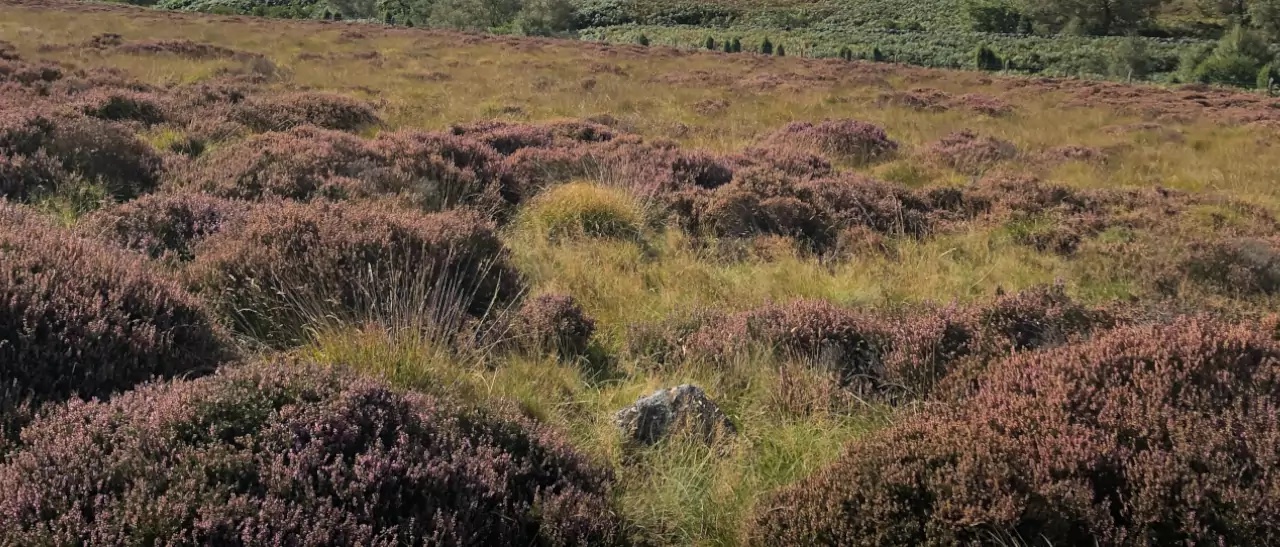Dwarf Shrub Regeneration
- Home
- What We Do
- Dwarf Shrub Regeneration

Lintzgarth was a typical overgrazed upland site when it was purchased by Philip Wayre in 2000. The site covers an area of 482 acres and rises to 554 metres above sea level. Philip purchased the site in order to safeguard and improve an integral part of an upland system which is vital for the survival of a number of species of birds. These include black grouse, golden plover, short-eared owl, merlin, grey partridge, and many others.
Much of the site is also based upon a good depth of peat and the management of the site is crucial in the context of safeguarding the carbon store which is contained under the sward. Although the Trust made changes to the grazing regime, due to the condition of the site when purchased substantial improvements to the sward had not been possible. Such changes, by improving the moss layer and dwarf shrub component, would enhance the capability of the site to catch and retain carbon as well as enhancing the site for breeding and over wintering birds, one of the aims of the Trust.
In 2016 to progress this aim the Trustees of the Philip Wayre Upland Trust decided to embark on a dwarf shrub regeneration project on plot 1505 to improve the diversity of the vegetation benefiting the resident black grouse population as well as other bird species.
Much of the plot totalling 20 acres had a deep litter layer which had built up as a result of changes to the grazing regime as well as a high covering of star moss, indicative of earlier overgrazing, which was hampering any recovery of more suitable vegetation. Heather seed requires daylight in order to germinate so it was agreed with Defra that the moss layer could be removed before any seeding of dwarf shrub could take place. As star moss is not easy to kill, the Trust used a light machine with low pressure tracks and a 2 metre bucket. The aim was to work a grid type basis of 5 five meter squares. However due to water seepage routes it was decided to remove the star moss in a less uniform way still with one square bared off and one left to avoid any erosion. The bared areas were reseeded by hand using one kilo of seed per hectare when the weather was dry with a light breeze. The surplus vegetation was compacted between every bared area which formed small hummocks, adding to shelter and topography. Approximately 15 acres of the 20 acre site was done in this manner. This resulted in some 7.5 acres being reseeded as half of the treated area was left untouched for the time being.
The bared areas were treated by seed on a fifty fifty basis, with one plot receiving heather seed and the adjacent one being seeded by a more complete mix of moorland species. In conjunction with the AONB team at Stanhope the bared areas were planted with sphagnum moss at the same time. This work took place in March 2016 before the onset of the bird breeding season. It was anticipated, due to the nature of dwarf shrub seed, that germination would be spread over two or three seasons from the one application of seed and so far this has proved to be the case with some seedlings being noticed in the first summer and more evident in 2017. It was noticeable that the sphagnum pellets took longer than expected to break down as the weather was so dry in the summer of 2016. In the later part of 2016 the Trust acquired 12,000 heather plugs which were planted in October on the same area, again by hand. The edges of the other five acres on plot 1505 were planted with approximately 1700 bare rooted shrubs and trees such as willow and alder. This planting was specifically to benefit the black grouse providing shelter in the future.
In tandem with the above a small area near the bird hide on plot 1371 was flailed and vegetation raked off. This was then treated with mixed heather seed in May 2016 and the area marked off with pegs. At the same time three small areas of drainage soil in the cleugh in plot 5157 were treated with heather seed.
Monitoring of the areas continues and the Trust is pleased to report evidence of heather growth in nearly all of the squares originally planted. The dry summer of 2018 suited our reseeding site 1505 in that the heather seedlings grew well, indeed some of them flowered, which is good for a plant which is not noted for fast growth in the wild. Many of the areas are also showing good signs of sphagnum regeneration as opposed to the almost blanket star moss which previously had dominated the vegetation structure.
It was noticeable that the black grouse population was utilising the site 1505 both for shelter and also for food as the cotton grass has also flourished following the work. Black grouse make considerable use of the flower heads as spring food, the flowers being high in nutrition. At least one brood was located within the site later in the summer of 2019. On monitoring the progress in 2020 it was evident that from a habitat standpoint there is considerable improvement. There is a real mix of bent grass and heather in the plots. There is evidence of the heather being eaten by either black or red grouse which is one of the main aims of the project. On other plots there is a good take of sphagnum moss and cotton grass, both narrow and broad leaved, as well as heather. It is possible the site could now benefit from a further scattering of heather seed which would add to the variation.
